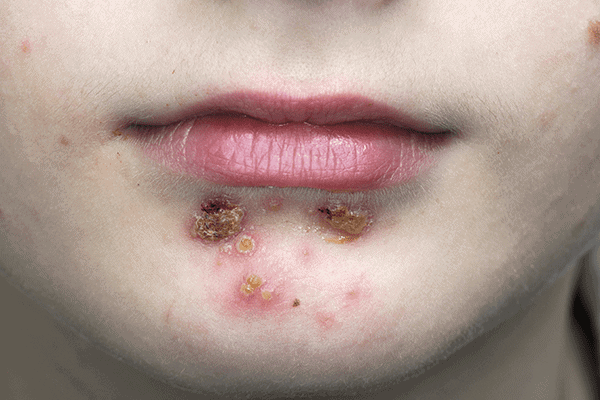School Sores – yuck! Unfortunately, the chances of them infiltrating your home are more likely than not. Here’s what you need to know about why they occur, what to do about them and how to (attempt) to avoid them. Gross image warning in place!
What are School Sores?
School sores are known medically as Impetigo. They’re an infection of the skin most often found in early childhood. See also – head lice! Eeeeek!
The bacteria that cause school sores usually reside in the impacted areas (skin, throat and nose) without issue. The issue is that they’re spread easily by skin-to-skin contact (hard to avoid when it comes to kids!) and that’s when the infection takes place. You might find that they appear after the skin has been impacted by something like a scratch or bite or maybe a communicable disease like chicken pox or an inflamed condition like eczema.
You’ll find that once school sores take hold they can pop up anywhere! You’ll usually find them near the mouth (not to be confused with hand, foot and mouth disease) or on the arms and legs of the child. They can also by found on the torso and in some cases around the crotch.
What are school sores like?
We’d like to stress that it’s important to seek the advice of medical professionals when it comes to diagnosing any health issue that anyone in your family has.
School sores appear as a cluster of blisters that burst and then weep. They’ll then become coated with a crust-like substance (almost honey-like in consistency). Sometimes there will be small spots that spread outwards and, generally speaking, they are ITCHY.
From first contact, you’re looking at between 4-10 days for the school sores to develop so make sure you don’t speak too soon about having avoided them!
The sores are infectious until the weeping stops. If treated properly (after seeing your doctor) with an ointment or medicine then this should be about 24 hours after treatment.
How do school sores spread?
As we all know – kids communicate diseases back and forth between them like nobody’s business. As school sores are quite itchy, and kids find it hard to resist the urge to scratch, the infection can easily jump to the child sitting next to them.
The healing sores as well as their dressings should also be considered to be infectious. This includes bedding, clothing, towels and other materials so be cautious with washing.
How should we treat school sores?
Again, please consult with your medical professional. They will be able to prescribe an appropriate course of treatment and help you figure out how to best wash the school sores and apply the cream. It’s tricky but the child will also have to avoid scratching and touching the school sores (often easier said than done) so consider trimming those fingernails and applying firm dressing.




